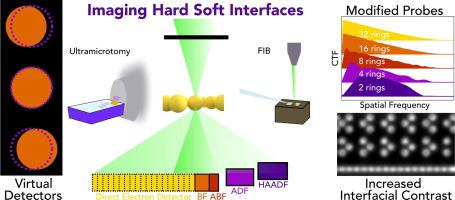Materials Today ( IF 24.2 ) Pub Date : 2021-06-19 , DOI: 10.1016/j.mattod.2021.05.006 Stephanie M Ribet 1 , Akshay A Murthy 1, 2 , Eric W Roth 3 , Roberto Dos Reis 1, 3 , Vinayak P Dravid 1, 2, 3

|
Inspired by the unique architectures composed of hard and soft materials in natural and biological systems, synthetic hybrid structures and associated hard-soft interfaces have recently evoked significant interest. Soft matter is typically dominated by structural fluctuations even at room temperature, while hard matter is governed by rigid mechanical behavior. This dichotomy offers considerable opportunities to leverage the disparate properties offered by these components across a wide spectrum spanning from basic science to engineering insights with significant technological overtones. Such hybrid structures, which include polymer nanocomposites, DNA functionalized nanoparticle superlattices, and metal organic frameworks to name a few, have delivered promising insights into the technologically relevant applications such as catalysis, environmental remediation, optoelectronics, and medicine.
The interfacial structure between the hard and soft phases demonstrates features across a variety of length scales and often strongly influence the functionality of hybrid systems. While scanning/transmission electron microscopy (S/TEM) has proven to be a valuable tool for acquiring intricate molecular and nanoscale details of these interfaces, the unusual nature of hybrid composites presents a suite of challenges that make assessing or establishing structure–property relationships especially difficult. There are additional considerations at all stages of sample analysis from preparing electron-transparent samples to obtaining sufficient contrast to resolve the interface between dissimilar materials given the dose sensitivity of soft materials.
We discuss each of these challenges and supplement a review of recent developments in the field with additional experimental investigations and simulations to present solutions for attaining a nano or molecular-level understanding of these interfaces. These solutions present a host of opportunities for investigating the role interfaces play in this unique class of functional materials.
中文翻译:

充分利用您的电子:使用 STEM 表征混合界面的挑战和机遇
受自然和生物系统中由硬质和软质材料组成的独特架构的启发,合成混合结构和相关的软硬界面最近引起了极大的兴趣。即使在室温下,软物质通常也受结构波动的支配,而硬物质则受刚性机械行为的支配。这种二分法提供了相当多的机会来利用这些组件提供的不同属性,范围广泛,从基础科学到具有重要技术意义的工程洞察力。此类混合结构,包括聚合物纳米复合材料、DNA 功能化纳米粒子超晶格和金属有机框架等,为催化等技术相关应用提供了有希望的见解,
硬相和软相之间的界面结构展示了各种长度尺度的特征,并且通常强烈影响混合系统的功能。虽然扫描/透射电子显微镜 (S/TEM) 已被证明是获取这些界面的复杂分子和纳米级细节的宝贵工具,但混合复合材料的不寻常性质提出了一系列挑战,尤其是评估或建立结构-性能关系难的。鉴于软材料的剂量敏感性,从制备电子透明样品到获得足够的对比度以解决不同材料之间的界面,样品分析的所有阶段都有其他考虑因素。
我们讨论了这些挑战中的每一个,并通过额外的实验研究和模拟补充了对该领域最新发展的回顾,以提出实现对这些界面的纳米或分子水平理解的解决方案。这些解决方案为研究界面在这类独特功能材料中所起的作用提供了大量机会。


























 京公网安备 11010802027423号
京公网安备 11010802027423号